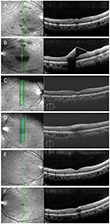J Korean Ophthalmol Soc.
2019 Dec;60(12):1352-1355. 10.3341/jkos.2019.60.12.1352.
Anemic Retinopathy after Chemotherapy
- Affiliations
-
- 1Department of Ophthalmology, Seoul National University Hospital, Seoul National University College of Medicine, Seoul, Korea. baeklok@snu.ac.kr
- KMID: 2466195
- DOI: http://doi.org/10.3341/jkos.2019.60.12.1352
Abstract
- PURPOSE
To report a case of anemic retinopathy after chemotherapy.
CASE SUMMARY
A 32-year-old male presented with visual disturbance in both eyes. He had been diagnosed with testicular cancer and had undergone right orchiectomy 4 months prior. He completed adjuvant chemotherapy 2 weeks before presentation. His best-corrected visual acuities were 20/35 in both eyes. Fundus examination revealed multiple flame-shaped hemorrhages around the posterior pole, and boat-shaped hemorrhages on the macula in both eyes. Laboratory results showed that he had reduced hemoglobin (5.5 g/dL) and platelet counts (77,000/µL). After transfusion, visual acuities were improved and retinal hemorrhages were resolved along with normalization of the hematological conditions.
CONCLUSIONS
Many ocular and medical conditions can cause bilateral retinal hemorrhages. This case emphasizes that comprehensive history evaluation, systemic evaluation, and laboratory findings, as well as a detailed fundus examination, are important in the diagnosis of patients with bilateral retinal hemorrhages.
Keyword
MeSH Terms
Figure
Reference
-
1. Carraro MC, Rossetti L, Gerli GC. Prevalence of retinopathy in patients with anemia or thrombocytopenia. Eur J Haematol. 2001; 67:238–244.2. Duke-Elder S, Dobree J. Duke-Elder Sm, editor. System of ophthalmology (diseases of the retina). St. Louis: CV Mosby Co.;1967. p. 373–407.3. Rubenstein RA, Yanoff M, Albert DM. Thrombocytopenia, anemia, and retinal hemorrhage. Am J Ophthalmol. 1968; 65:435–439.4. Foulds W. The ocular manifestations of blood diseases. Trans Ophthalmol Soc U K. 1963; 83:345–367.5. Kawai K, Ando S, Hinotsu S, et al. Completion and toxicity of induction chemotherapy for metastatic testicular cancer: an updated evaluation of Japanese patients. Jpn J Clin Oncol. 2006; 36:425–431.6. Kacer B, Hattenbach LO, Hörle S, et al. Central retinal vein occlusion and nonarteritic ischemic optic neuropathy in 2 patients with mild iron deficiency anemia. Ophthalmologica. 2001; 215:128–131.7. Celebi S, Kükner A. Photodisruptive Nd: YAG laser in the management of premacular subhyaloid hemorrhage. Eur J Ophthalmol. 2001; 11:281–286.
- Full Text Links
- Actions
-
Cited
- CITED
-
- Close
- Share
- Similar articles
-
- Radiation Retinopathy Following Cephalic Radiation
- The Influences of Arteriosclerosis on the Development and Progression of Diabetic Retinopathy
- The iron status, clinical symptom and anthropometry between normal and anemic groups of middle school girls
- Clinical Review on Diabetic Retinopathy
- Hue Discrimination and Contrast Sensitivity Deficits in Diabetic Subjects With and Without Retinopathy



